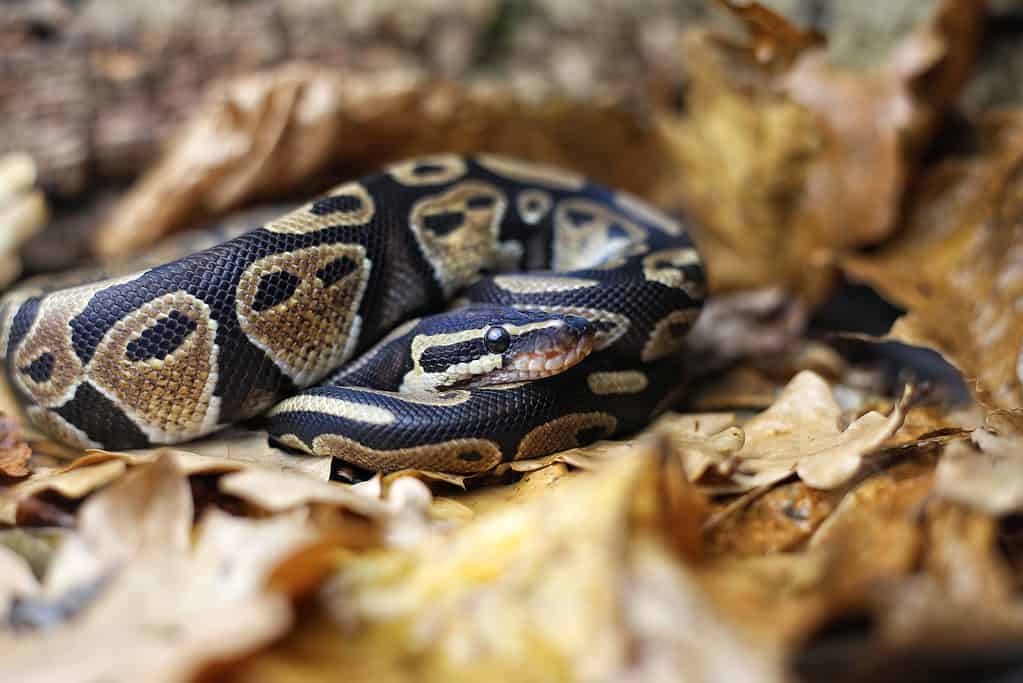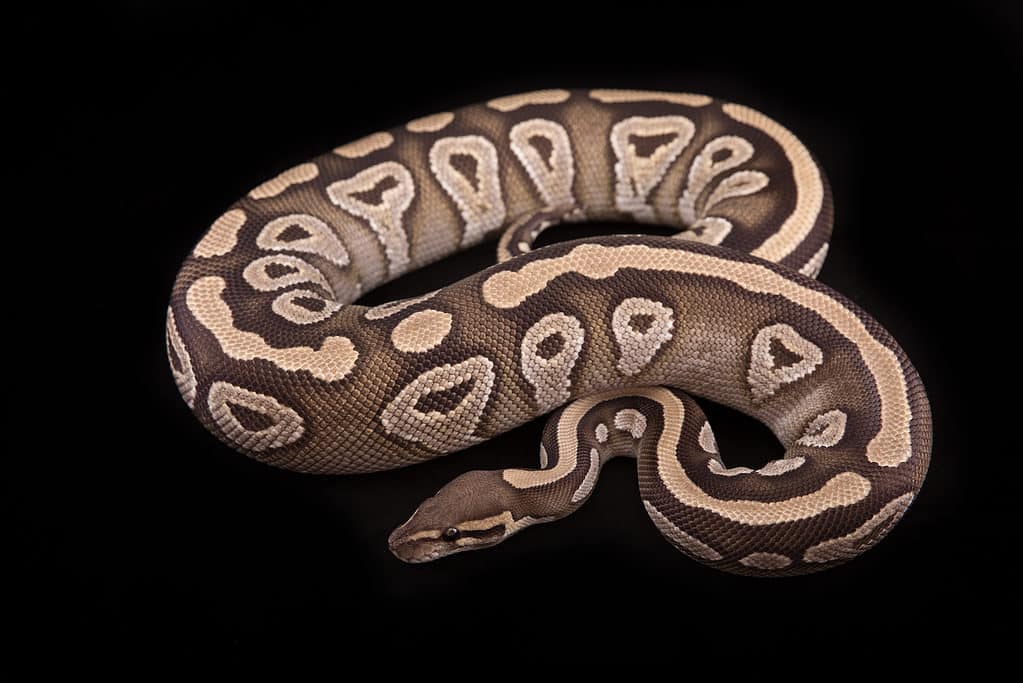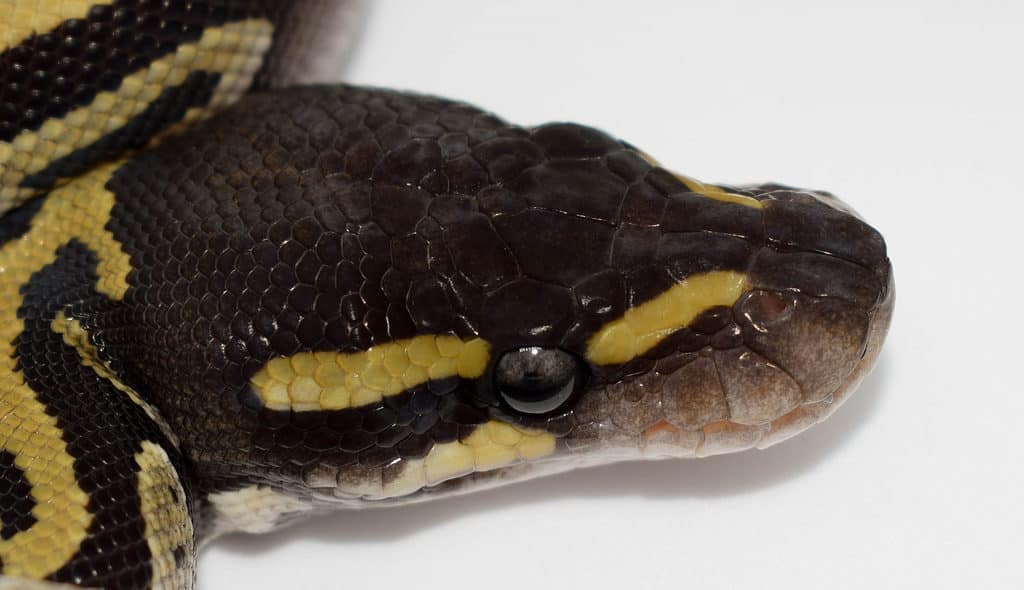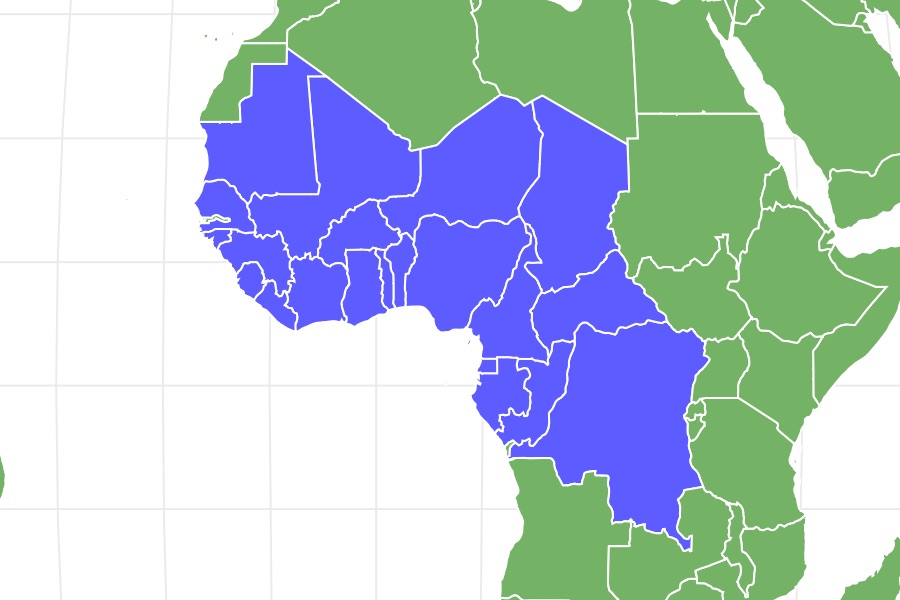Mojave Ball Python
Python regius
Instead of the typically banded or ‘alien head’ patterning of most ball python morphs, the Mojave morph’s patterning is characterized by lots of large, circular splotches with small, dark brown dots in their centers.
Advertisement
Mojave Ball Python Scientific Classification
- Kingdom
- Animalia
- Phylum
- Chordata
- Class
- Reptilia
- Order
- Squamata
- Family
- Pythonidae
- Genus
- Python
- Scientific Name
- Python regius
Read our Complete Guide to Classification of Animals.
Mojave Ball Python Conservation Status
Mojave Ball Python Facts
- Prey
- Rodents, birds, amphibians, fish
- Main Prey
- Small rodents
- Group Behavior
- Solitary
- Fun Fact
- Instead of the typically banded or ‘alien head’ patterning of most ball python morphs, the Mojave morph’s patterning is characterized by lots of large, circular splotches with small, dark brown dots in their centers.
- Temperament
- Docile, curious, hardy
- Habitat
- Grasslands, savannas, forests
- Diet
- Carnivore
- Lifestyle
- Nocturnal
- Special Features
- Unique "Mojave" pattern, high-contrast markings
- Location
- Western and central Africa
View all of the Mojave Ball Python images!
Named after the Mojave Desert, the Mojave ball python is a co-dominant base morph of ball python. It was first developed in 2000 by Utah-based breeders Dan and Collette Sutherland at The Snake Keeper, Inc.
The Mojave trait significantly alters the affected snake’s patterning. Rather than having the usual banded or “alien head” body pattern present in most morphs, the Mojave morph’s patterning resembles lots of large, round, bullseye-like splotches. The splotches are usually tan, gold, or light brown with a very dark brown or black center.
Their exact coloration can vary, but Mojave ball pythons are usually high-contrast snakes with lots of golden, gray, and dark brown tones. In more recent years, the Mojave morph has been combined with other traits to create designer morphs. These include the Pastel Mojave, Super Mojave, and Firefly Mojave.
5 Amazing Mojave Ball Python Facts!
- To date, only one Mojave ball python has been found in the wild. This means all existing Mojave ball pythons are likely this snake’s descendants! Base morphs like the Mojave can technically occur in the wild naturally, but this is extremely rare.
- Based in Utah, the breeders at The Snake Keeper, Inc. named the Mojave morph after the nearby Mojave Desert.
- The Super Mojave morph was developed in 2003 by breeding two Mojave ball pythons together.
- Reptile breeders often combine the Mojave morph with other traits to pass on its striking keyhole/bullseye body pattern.
- While the majority of the Mojave morph’s body is bold and quite colorful, its belly is typically solid white with little to no markings.
Where to Find Mojave Ball Pythons
The standard, wild-type ball python lives throughout western and central Africa in a variety of habitats. It prefers grasslands, savannas, and occasionally sparsely forested areas with open clearings near water. The species has established large populations in countries like Nigeria, Ghana, and Senegal.
The Mojave morph in particular is quite notable for the fact that it has been documented in the wild. Only one individual has actually been confirmed, though. Many reptile breeders suspect all existing Mojave ball pythons are descendants of this one individual snake! While base morphs like the Mojave can randomly occur in the wild, this is exceedingly rare, and very little documentation exists of verified occurrences.
Today, Mojave ball pythons are commonly sold worldwide both online and at events like reptile expos. They are sold by a wide range of dedicated breeders who have since created their own Mojave lines. They cost around $80 to $150. Also, they are one of the least expensive morphs on the market, in part because it has existed for more than 20 years.
Although it was developed back in 2000 and was one of the earliest base morphs to become popular in the exotic pet trade, it remains extremely popular with reptile enthusiasts of all backgrounds and experience levels.
Mojave Ball Python Scientific Name
The ball python’s scientific name is Python regius, which translates to “royal python.” It is one of the smallest species in the python family and has no subspecies. Because all ball python morphs are the same species, they all have the same scientific name and taxonomic classification.
Interestingly, the ball python’s regal moniker refers to how Egypt’s ancient royals are believed to have decorated their bodies with live snakes to boldly show off their status and wealth. Royals like Cleopatra herself likely “wore” baby ball pythons around their wrists as bracelets!
Mojave Ball Python Population and Conservation Status
The IUCN Red List has designated the ball python as near-threatened since 2012. This means the species has experienced a slight decline in population throughout its native range in Africa. However, it is not at immediate risk of going extinct.
The main reasons for the ball python’s near-threatened status are habitat loss and humans hunting the snakes for food and the exotic pet trade. In particular, the increasingly rapid expansion of Africa’s agricultural industry has significantly reduced the ball python’s habitat range. Deforestation for various industries is also a major factor.
How to Identify Mojave Ball Python: Appearance and Description
The Mojave morph is one of the more easily recognizable traits due to its very distinct body pattern. Its exact coloration can vary significantly. All Mojave ball pythons, though, have the trademark “Mojave pattern.” That is characterized by large, round splotches with smaller, darker spots in their centers. The splotches are usually tan, gold, grayish, or light brown. Their keyhole or bullseye-like centers are small dark brown or black dots.
In addition to its bold pattern, the Mojave morph has a few other defining traits. Perhaps the most notable is its high-contrast markings with very little blushing aside from the top of the head. Its bright yellow eye stripes are also especially vibrant and contrast its dark brown head beautifully. Most Mojave ball pythons also have solid white bellies.
In short, these key traits define the Mojave ball python:
- “Mojave pattern” that resembles lots of large, round bullseyes with dark brown centers extending down the snake’s entire body
- High-contrast patterning that can vary in color but typically has mainly gold, gray, and dark brown tones
- Very bright yellow eye stripes in contrast to its mostly dark brown head
- Very little blushing aside from the pale spot atop the center of the head
- Solid white belly with no markings
Mojave Ball Python Evolution and History
The Mojave morph is a co-dominant, single-gene base morph developed in 2000 by Dan and Collette Sutherland of The Snake Keeper, Inc., based in Utah. The morph’s name is inspired by the Mojave Desert. Notably, TSK has also developed other popular morphs, such as the Inca and Tri-Stripe varieties.
In more recent years, reptile breeders have combined the Mojave morph with various other traits, such as the Pastel Mojave, Cinnamon Mojave, and Mojave Pied variants. Additionally, in 2003, breeder Wes Harris developed the Super Mojave morph by breeding two Mojave ball pythons together.
The Mojave morph has remained extremely popular despite thousands of new traits hitting the market over the years. Its distinct patterning, minimal blushing, vibrant eye stripes, and high-contrast appearance make it a favorite among reptile breeders looking to pass on the Mojave pattern and “clean up” future offspring’s markings.
Mojave Ball Python Pictures

The Mojave ball python is a base morph mutation of the ball python.
©Marina Kehl/Shutterstock.com

Like all
ball pythons
, Mojave ball pythons are one of the smallest python species, usually only reaching lengths of five feet.
©Sanne Romijn Fotografie/Shutterstock.com

Bred in 2000, the Mojave ball python coloration can vary, but is typically in the range of brown, black, and gold.
©pelsopython/Shutterstock.com
Mojave Ball Python: How Dangerous Are They?
Regardless of the morph, all ball pythons generally possess the same timid, gentle temperament. They are non-venomous and one of the smallest python species, typically reaching only 5 feet in length. They are not considered to be dangerous to humans. In fact, the ball python’s small size and agreeable personality have resulted in it becoming one of the most popular pet reptiles in the world!
Amusingly, the ball python actually gets its common name from its bizarre yet adorable defense mechanism: curling its entire body into a tiny ball. While many snakes will either bite or lift their bodies into a more intimidating posture to scare off predators, ball pythons will usually either flee from a perceived threat or curl up in a ball to make themselves look smaller.
If you are bitten by a ball python, you likely won’t need much medical intervention aside from warm water, soap, and a Band-Aid. Because they have very thin, small, fragile teeth rather than true fangs, their bite is very weak and cannot do much damage to humans.
Mojave Ball Python Behavior and Humans
As we briefly covered earlier, the ball python is one of the most lovable stars of the reptile world for a few key reasons. Most notable is its incredibly gentle yet curious and hardy temperament, making it an enjoyable companion that tolerates handling very well. Since all ball python morphs are the same species, they all tend to have similar personalities. They also share the same care requirements.
Another important trait that makes the ball python so beloved by humans is its small, manageable size. While many other python species can reach well over 20 feet long and weigh more than 100 pounds, ball pythons are far more compact at around 5 feet in length. They also keep very well in captivity and can even live in enclosures as small as 50 to 60 gallons.
Even though ball pythons only became popular pets fairly recently in the mid-1990s, they are now one of the most commonly kept pet reptiles worldwide. Around 4,000 distinct morphs have been developed since 1995, and many more are being created all the time by hundreds of different breeders.
Related Animals…
View all 164 animals that start with MMojave Ball Python FAQs (Frequently Asked Questions)
Are Mojave ball pythons venomous?
Ball pythons are not venomous, no matter what morph they are or the traits they possess. They are members of the python family and are therefore constrictor snakes that do not need venom to take down their prey. Ball pythons also rarely bite thanks to their shy nature and very weak, small teeth.
How do Mojave ball pythons hunt?
Ball pythons hunt similarly to most other python species–that is, by lying in wait and ambushing anything small enough that crosses their path. Instead of relying on their venom, they will strike their prey, biting into the animal before quickly coiling their entire body around it as tightly as possible. Once the prey has suffocated, the snake will slowly swallow it whole.
Are Mojave ball pythons aggressive?
All ball python morphs have the same mild-mannered yet active and curious temperament. They are not aggressive towards humans.
Where do Mojave ball pythons live?
The wild-type ball python is native to central and western Africa, mainly within the Sub-Saharan region. Ball pythons are hardy and can live in various habitats, but they most often frequent savannas, grasslands, and sparsely wooded forests.
What do Mojave ball pythons eat?
All ball python morphs are carnivorous and share the same dietary requirements. They feed mainly on small rodents and birds but will also sometimes hunt small amphibians and fish.
How much do Mojave ball pythons cost?
The Mojave morph is one of the most inexpensive and accessible morphs on the market today. A single Mojave ball python averages around $80 to $150. However, Mojave ball pythons with additional traits, like the Super Mojave or Cinnamon Mojave, can be significantly more costly.
Are Mojave ball pythons rare?
Mojave ball pythons are not rare in captivity, as the morph has existed for decades. What’s more, many breeders worldwide now have their own Mojave lines. They are, however, extremely rare in the wild. To date, only one Mojave ball python has been found in its natural habitat.
Thank you for reading! Have some feedback for us? Contact the AZ Animals editorial team.
Sources
- IUCN Red List, Available here: https://www.iucnredlist.org/species/177562/15340592
- Morph Market, Available here: https://www.morphmarket.com/morphpedia/ball-pythons/mojave/
- Northwest Reptiles, Available here: https://www.nwreptiles.com/mojave/
- San Diego Zoo Wildlife Alliance, Available here: https://animals.sandiegozoo.org/animals/python
- World of Ball Pythons, Available here: https://www.worldofballpythons.com/morphs/mojave/

















